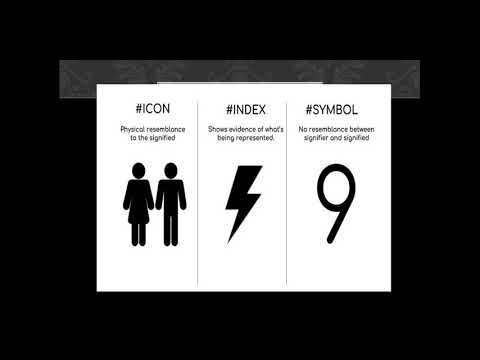Semiotics348
This video seeks to provide viewers a basic understanding of the semiotic theories of Ferdinand de Saussure and Charles Sanders Peirce. In this video, de Saussure’s theory of the dyadic relationship of the linguistic sign is compared to Peirce’s triadic relationship of the linguistic sign. For further information, please see:
de Saussure, Ferdinand. 1972. Course in General Linguistics. La Salle: Open Court.
de Waal, Cornelis. 2001. On Peirce. Belmont: Wadsworth. .




I appreciate you taking the time to make this video. You're voice is annoying, I'm sorry to say. You croak. It would be better (in this sense of convincing that you actually understand the material yourself) if you could recite these ideas and concepts without reading them. You talk like you're reading, not with the casual pauses of someone explaining something.
i get what you are saying. still i think your comment is unnecessary. (mine probably carries a "second order unnecessity" 😉
i think i just fell in love with you 😉
tomorrow I have an exam: semiotics. I came over here and watched your video many times and i got fresh because of your lovely sound. although I love british accent, but your voice makes american accent wonderful. so lovely and sweet. thanks, kissesssssssssssssss
man, i need to smoke more…
If you're into semiotics and i'm into semiotics, i think we should do some semiotics together. lol.
Tim Minchin reference?
lol. me too.
If only I could place my signifier in your signified to create a dyadic relationship in your underwear, the representatum.
Horrible speaking voice.Voice tone grates!
so does yours
The relationship between signified and signifier in onomatopoeia is arguably arbitrary actually.
just share the pdf if you're just going to read it out.
as Overtures said, in Saussure's work, onomatopoeia is as arbitrary as anything else, actually it's the perfect example of the arbitrary characteristic of signifier (think about representation of barking sound in different languages, they are completely different from each other)
A lot of haters in the comment section appear to be threatened by an intelligent woman.
Thanks for the vid. Your talk was efficient and helpful. I am now officially a fan of Charles Sanders Peirce. 🙂
Superb…!!!
You are an angel….I'd love to study semiotics with you 24/7…
I am even more confused about the triangle now.
Clicked to see if the impossible can be done, it can't. There were serious lacks and misconceptions in the Saussure part but ok (although you can get that information faster and cleaner even on the wikipedia in a couple minutes). However the Peirce part was actually worse than getting no information at all on the subject as it was just all wrong and very misleading. It was brave of you to to try to do this but it unfortunately can't be done like this, the topic is too complicated to explain in such a short time to relatively undeducated viewers in any meaningful manner.
I'm so sick and tired about sexist comments here… but I would like to clarify the triangle, because your example is very badly versed, I would even say that it's completely wrong. It is actually very simple: shadow as a sign is always a shadow. It is obviously some lack of light caused by a hand that is interpreted as a shadow, but the hand or the lack of light are not alone anywhere in the triad. The example should be: REPRESENTAMEN: some darker area on a wall as it might be seen; OBJECT: a hand that is blocking light so it does not shine directly on the wall; INTERPRETANT: possible idea/concept of a shadow as a result of a hand blocking light
Leting alone that the whole triangle is in fact very problematic and should not be used when explaining Peirces semeiotic at all.
Thank you